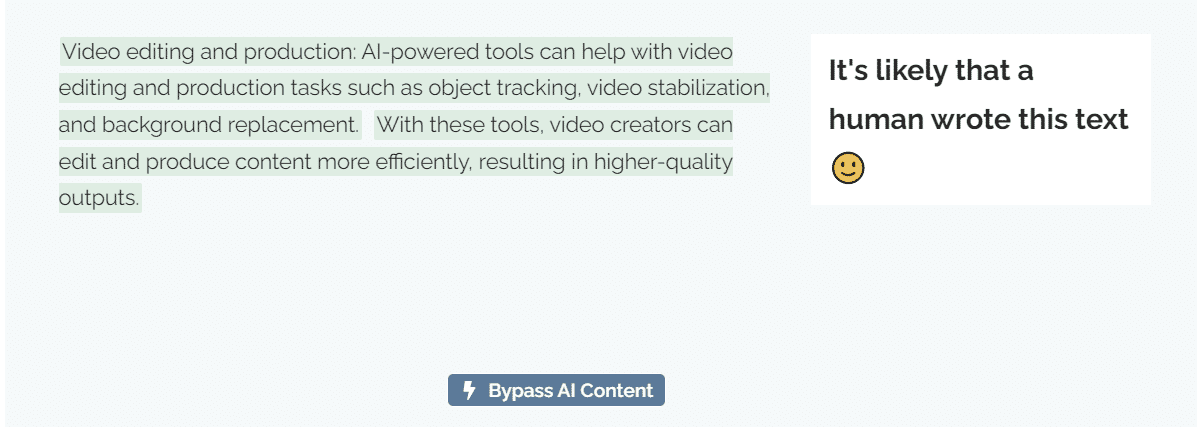AI has become a big part of creating content these days. It’s like a secret helper that makes the content better without us even realizing it. It’s making blogs, videos, podcasts, and even memes better than ever before.
Better stated, it’s the invisible hand, guiding writers to produce better, smarter content.
With the advent of content generators, there’s the newest technology in this digital hall: AI content detectors.
These unseen protectors are reshaping content creation’s landscape. The mission? To diligently scan, analyze, and refine the sea of content we navigate daily.
Contents
So, What Are AI Content Detectors?
The AI content detector is a tool that employs machine learning algorithms to identify and flag AI-generated text such as by using ChatGPT. These tools use complex linguistic analysis techniques to compare the text against a vast corpus of known machine-generated content.
These detectors analyze various linguistic features such as syntax, vocabulary, tone, and style, thereby differentiating between human-written and AI text. They can also provide detailed reports highlighting the suspicious phrases or sentences that require further investigation.

A Look Back: The Evolutionary Tale of AI Content Detectors
AI detectors didn’t just appear overnight. Their story is one of continuous evolution, shaped by technological advances and growing demand for quality content.
The early versions were introductory, primarily designed to spot obvious plagiarism or repetition. Over time, they’ve evolved into sophisticated systems, capable of deep content analysis, thanks to continuous learning and refinement.
Behind AI content detectors’ rise are several key technological advancements. Machine learning, natural language processing, and data analytics are the key sparks that ignited this transformative flame.
These technologies have given detectors the ability to ‘understand’ content, interpret context, and make complex assessments – attributes once thought to be exclusive to humans.
Stepping into the spotlight, we see a few key players shaping this industry. Companies like Paraphrasingtool.ai and OpenAI are making waves with their cutting-edge detectors.
Their tools are not just software; they are at the forefront of a new era in content creation.
Functioning of AI Content Detectors: Behind the Scene
The AI system is trained on a large dataset of labeled content, where each piece of content has been categorized as acceptable.
Based on this data, the AI system can learn to recognize patterns in the content and identify features that indicate the presence of problematic content.
Once trained, the AI system can then use these patterns and features to automatically flag potentially problematic content in real-time.
As mentioned above, ML, NLP, and data analytics play a critical role in the functioning of AI content detectors. These systems are trained on large datasets of labeled content. The more data the system is trained on, the more accurate it becomes at detecting problematic content.
In addition to training data, machine learning algorithms also use feedback from moderators to improve their accuracy over time. If a piece of content is flagged as problematic but is determined to be acceptable upon further review, the AI system can learn from this mistake and adjust its rules accordingly.
Impact of AI Content Detectors on the Creation Process
AI content detectors have significantly impacted the content creation process, changing the way content is produced, published, and promoted online.
Let’s explore how these systems are reshaping the content creation landscape.
Real-Time Feedback for Creators
One of the most significant ways content detectors are changing the content creation landscape is by providing creators with real-time feedback on the acceptability of their content. Creators can use these tools to ensure that their content meets certain standards, such as avoiding AI language or complying with copyright laws.
Plagiarism Detection Made Easy
It also plays a crucial role in plagiarism detection, enabling content creators to identify and prevent the use of unauthorized content. This is particularly important for creators who publish content on multiple platforms. It can help them avoid duplicating content or accidentally using copyrighted material.
Revolutionizing SEO Optimization
Another way that these tools are changing the content creation landscape is through their impact on search engine optimization (SEO). By analyzing content for keywords and other SEO factors, these tools can help creators improve the visibility and ranking of their content on search engines.
Pros and cons of AI content detectors:
While AI content detectors have many benefits, they also have some drawbacks that creators must consider.
Pros
Some of the pros of using AI content detectors include:
- Improved content quality: AI content detectors can help creators produce higher-quality content by identifying and flagging AI content or other issues.
- Faster results: By providing real-time feedback, AI content detectors can help creators save time.
- Enhanced plagiarism detection: AI content detectors can quickly identify instances of plagiarism and prevent creators from using unauthorized or AI content.
Cons
However, there are also some cons to using AI content detectors including:
- Overreliance on technology: You may become overly reliant on AI content detectors, potentially sacrificing your own judgment and creativity.
- False positives: AI content detectors may flag content as problematic that is actually acceptable, leading to unnecessary moderation or censorship.
- Limited scope: They are currently limited in their ability to analyze complex content, such as satire or sarcasm, and may struggle to accurately identify certain types of problematic content.
The Future of AI Content Detectors
AI content detectors have become an important tool in content creation, particularly when it comes to detecting AI-generated content.
While AI-generated content has the potential to be accurate and informative, there are also risks associated with its use.
For example, some AI-generated content may contain errors, bias, or other inaccuracies that could mislead readers. In such cases, these detectors can play an important role in identifying and flagging such content for further review.
However, it is important to note that not all AI-generated content is inherently risky or unreliable.
When used responsibly and with careful consideration, AI-generated content can be a valuable tool for content creators. It is particularly useful in generating large amounts of text quickly and efficiently.
Looking to the future, it is likely that these tools will continue to play an important role in content creation, particularly as AI technology continues to advance.
However, it is also possible that these tools may become less necessary as AI-generated content becomes more sophisticated and challenging to distinguish from human-generated content.
Overall, the future of AI content detectors and AI-generated content is difficult to predict.
Regardless, the key to the safe and effective use of AI-generated content will always be careful consideration and critical analysis of the content itself, regardless of how it was generated.
Also, Read:
- How Social Media Boosts Your Online Sales?
- How to Create New Layer From Selection in Gimp
- Advantages And Disadvantages of HTML You Should Know
- How does Web Design Affect SEO?- All You Need To Know.
- WordPress Page Not Found After Publish? Easy Fix
- Webpage Is Currently Unable To Handle This Request. HTTP error 500 Fix
